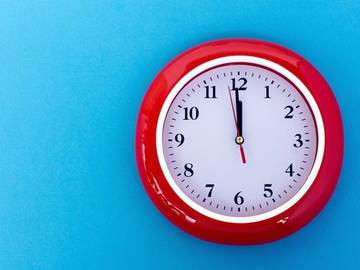There’s something aesthetically pleasing about the word noon. Its palindromic spelling feels appropriate for the middle of the day, when the sun is directly overhead and the hands on the clock are pointed upward in a straight line. It’s even spelled with letters found more or less in the middle of the alphabet.
But there was once a time when noon referred to a different time of day—and that fact is reflected in the word’s etymology.

But when's lunch?
Noon takes a path through Middle and Old English, where nōn denoted the ninth hour from sunrise. That word derives from the Latin nonus, meaning “ninth,” related to novem, the word for the number nine. If you mark sunrise at approximately 6:00 in the morning, that puts noon at around what we would now call 3:00 P.M. Romans called what we now call noon meridiem, literally the “middle of the day”; hence our designations A.M. (for ante meridiem) and P.M. (post meridiem) for the hours before and after the noon hour.
So what was special about that ninth hour? In Christian liturgy, the nones, or ninth hour, was one of the three times of day (along with morning and evening) set aside for prayer. The ninth hour is significant at numerous points in Scripture; in the Gospel of Mark, the hours leading up to the crucifixion of Jesus is described as “darkness over the whole land until the ninth hour” in the King James Version and as lasting “until three in the afternoon” in the New International Version.
It is believed that the time allotted for this prayer gradually moved up earlier in the day, perhaps at the urgency of monks who would could only end their fast after the prayer was completed. That time known as noon eventually settled on the time when the sun was in the middle of the sky.
From there we acquired the word afternoon, formed in 13th-century Middle English as afternone, originally referring to the period of day after the midday meal but before the evening meal. High noon has no additional meaning apart from “noon”; high sets noon as a precise rather than approximate time, but doesn’t refer to the position of the sun at noon; it was once used for midnight as well.
Now is it time for lunch?




